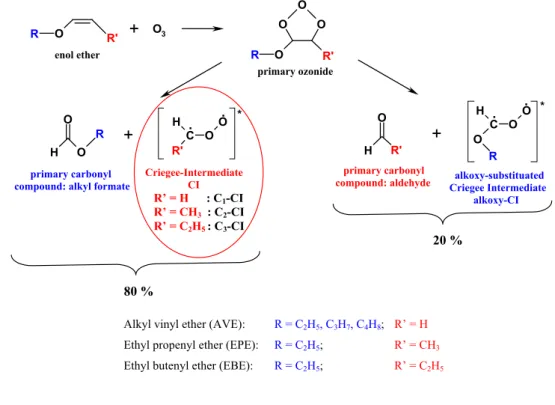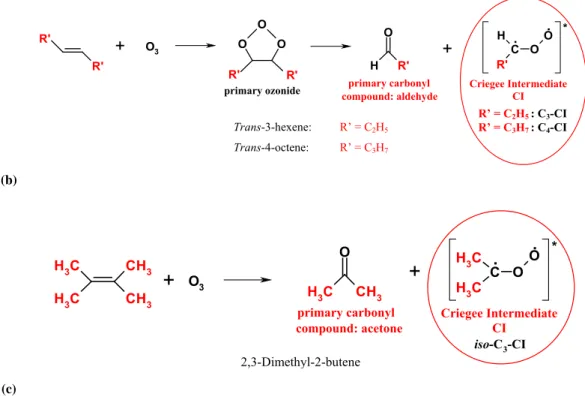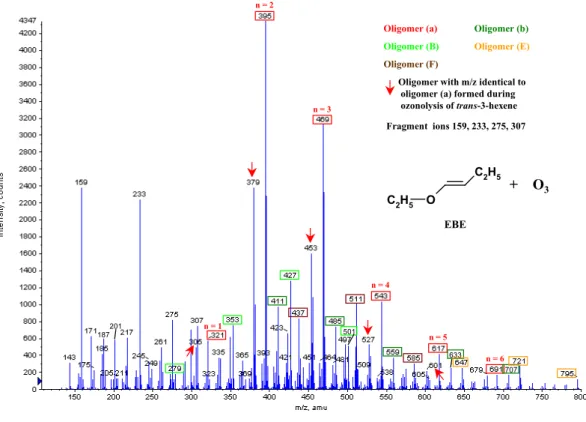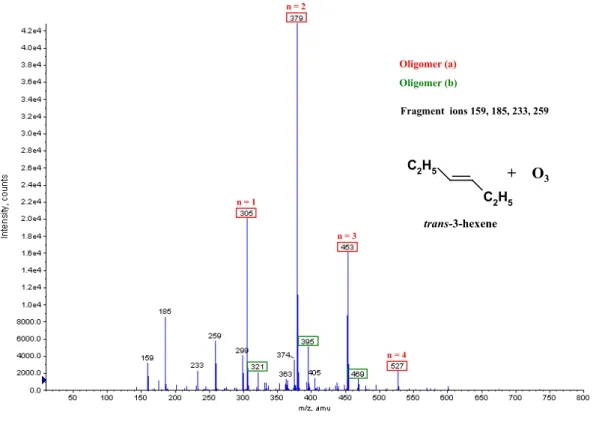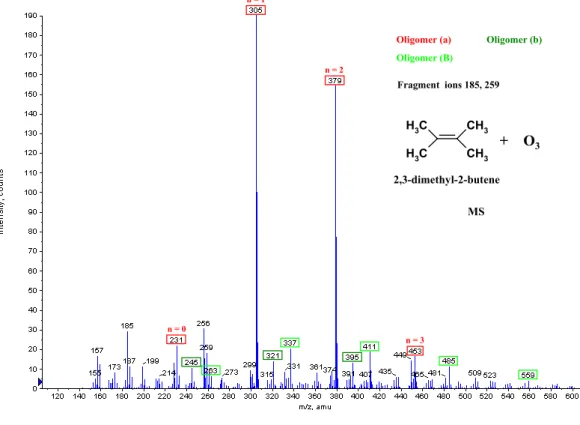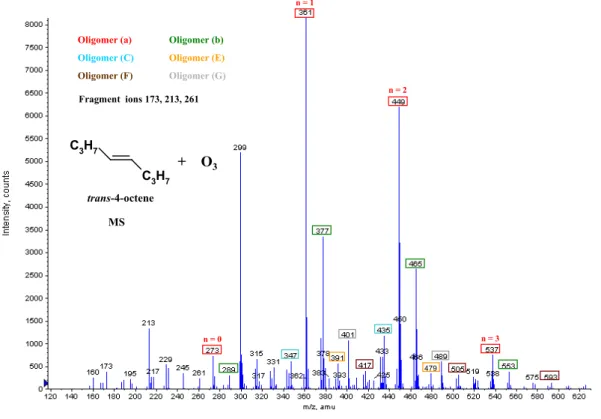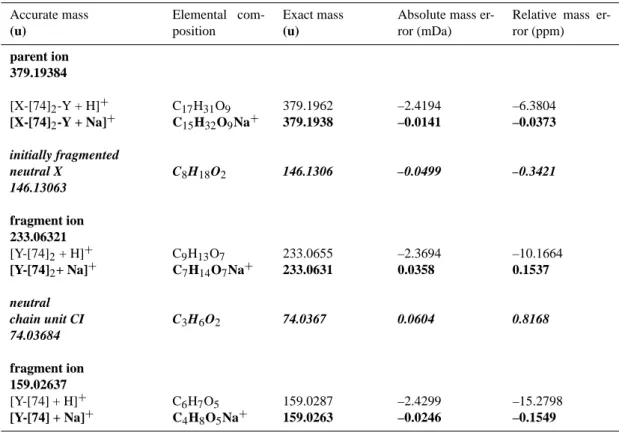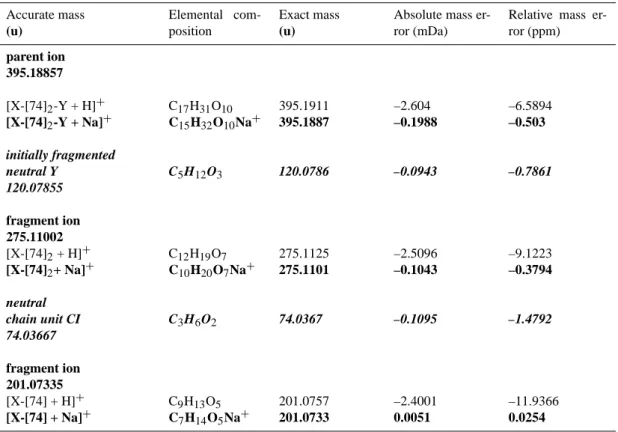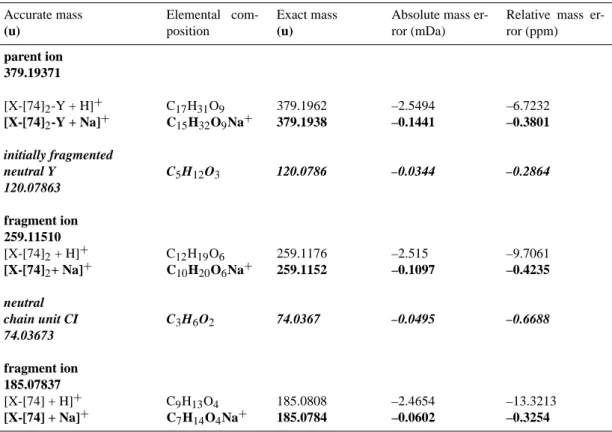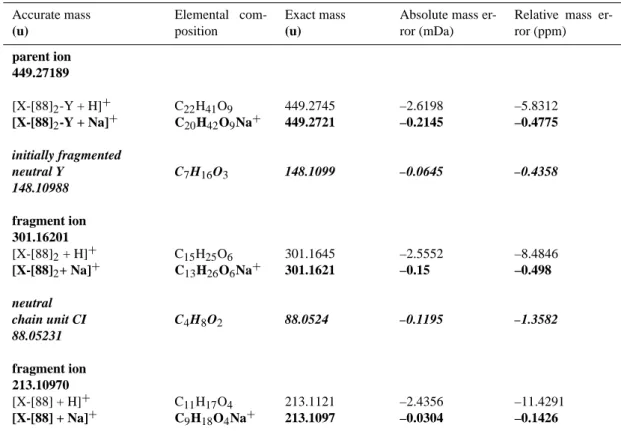HAL Id: hal-00328590
https://hal.archives-ouvertes.fr/hal-00328590
Submitted on 10 Oct 2008
HAL is a multi-disciplinary open access
archive for the deposit and dissemination of
sci-entific research documents, whether they are
pub-lished or not. The documents may come from
teaching and research institutions in France or
abroad, or from public or private research centers.
L’archive ouverte pluridisciplinaire HAL, est
destinée au dépôt et à la diffusion de documents
scientifiques de niveau recherche, publiés ou non,
émanant des établissements d’enseignement et de
recherche français ou étrangers, des laboratoires
publics ou privés.
alkenes and enol ethers: new evidence for the central
role of the Criegee Intermediate as oligomer chain unit
A. Sadezky, R. Winterhalter, B. Kanawati, A. Römpp, B. Spengler, A.
Mellouki, G. Le Bras, P. Chaimbault, G. K. Moortgat
To cite this version:
A. Sadezky, R. Winterhalter, B. Kanawati, A. Römpp, B. Spengler, et al.. Oligomer formation during
gas-phase ozonolysis of small alkenes and enol ethers: new evidence for the central role of the Criegee
Intermediate as oligomer chain unit. Atmospheric Chemistry and Physics, European Geosciences
Union, 2008, 8 (10), pp.2699. �hal-00328590�
www.atmos-chem-phys.net/8/2667/2008/ © Author(s) 2008. This work is distributed under the Creative Commons Attribution 3.0 License.
Chemistry
and Physics
Oligomer formation during gas-phase ozonolysis of small alkenes
and enol ethers: new evidence for the central role of the Criegee
Intermediate as oligomer chain unit
A. Sadezky1,2, R. Winterhalter1, B. Kanawati1, A. R¨ompp3, B. Spengler3, A. Mellouki2, G. Le Bras2, P. Chaimbault4, and G. K. Moortgat1
1Max-Planck-Institute for Chemistry, Atmospheric Chemistry Department, P.O. Box 3060, 55020 Mainz, Germany
2Institut de Combustion A´erothermique R´eactivit´e et Environnement, CNRS, 1C Avenue de la Recherche Scientifique, 45071 Orl´eans Cedex 2, France
3Institut f¨ur Anorganische und Analytische Chemie, Justus-Liebig-Universit¨at, 35392 Giessen, Germany
4Institut de Chimie Organique et Analytique (ICOA), CNRS FR 2708, UMR 6005, Universit´e d’Orl´eans, BP 6759, 45067 Orl´eans C´edex 2, France
Received: 6 August 2007 – Published in Atmos. Chem. Phys. Discuss.: 4 October 2007 Revised: 26 March 2008 – Accepted: 9 April 2008 – Published: 21 May 2008
Abstract. An important fraction of secondary organic aerosol (SOA) formed by atmospheric oxidation of diverse volatile organic compounds (VOC) has recently been shown to consist of high-molecular weight oligomeric species. In our previous study (Sadezky et al., 2006), we reported the identification and characterization of oligomers as main con-stituents of SOA from gas-phase ozonolysis of small enol ethers. These oligomers contained repeated chain units of the same chemical composition as the main Criegee Intermedi-ates (CI) formed during the ozonolysis reaction, which were CH2O2(mass 46) for alkyl vinyl ethers (AVE) and C2H4O2 (mass 60) for ethyl propenyl ether (EPE). In the present work, we extend our previous study to another enol ether (ethyl butenyl ether EBE) and a variety of structurally re-lated small alkenes (trans-3-hexene, trans-4-octene and 2,3-dimethyl-2-butene).
Experiments have been carried out in a 570 l spherical glass reactor at atmospheric conditions in the absence of seed aerosol. SOA formation was measured by a scanning mo-bility particle sizer (SMPS). SOA filter samples were col-lected and chemically characterized off-line by ESI(+)/TOF MS and ESI(+)/TOF MS/MS, and elemental compositions were determined by ESI(+)/FTICR MS and ESI(+)/FTICR MS/MS. The results for all investigated unsaturated com-pounds are in excellent agreement with the observations of
Correspondence to: G. K. Moortgat (moo@mpch-mainz.mpg.de)
our previous study. Analysis of the collected SOA filter samples reveal the presence of oligomeric compounds in the mass range 200 to 800 u as major constituents. The re-peated chain units of these oligomers are shown to systemat-ically have the same chemical composition as the respective main Criegee Intermediate (CI) formed during ozonolysis of the unsaturated compounds, which is C3H6O2(mass 74) for ethyl butenyl ether (EBE), trans-3-hexene, and 2,3-dimethyl-2-butene, and C4H8O2(mass 88) for trans-4-octene. Analo-gous fragmentation pathways among the oligomers formed by gas-phase ozonolysis of the different alkenes and enol ethers in our present and previous study, characterized by successive losses of the respective CI-like chain unit as a neu-tral fragment, indicate a similar principal structure. In this work, we confirm the basic structure of a linear oligoperox-ide – [CH(R)-O-O]n – for all detected oligomers, with the repeated chain unit CH(R)OO corresponding to the respec-tive major CI. The elemental compositions of parent ions, fragment ions and fragmented neutrals determined by accu-rate mass measurements with the FTICR technique allow us to assign a complete structure to the oligomer molecules. We suggest that the formation of the oligoperoxidic chain units occurs through a new gas-phase reaction mechanism observed for the first time in our present work, which in-volves the addition of stabilized CI to organic peroxy rad-icals. Furthermore, copolymerization of CI simultaneously formed in the gas phase from two different unsaturated com-pounds is shown to occur during the ozonolysis of a mixture
of trans-3-hexene and ethyl vinyl ether (EVE), leading to for-mation of oligomers with mixed chain units C3H6O2(mass 74) and CH2O2(mass 46). We therefore suggest oligoperox-ide formation by repeated peroxy radical-stabilized CI addi-tion to be a general reacaddi-tion pathway of small stabilized CI in the gas phase, which represents an alternative way to high-molecular products and thus contributes to SOA formation.
1 Introduction
Organic material accounts for a substantial fraction of atmo-spheric fine particular matter that affects the global climate by direct and indirect effects as well as human health (P¨oschl, 2005, and references therein). Secondary organic aerosol (SOA) is formed by gas-to-particle conversion of products of the tropospheric oxidation of volatile organic compounds (VOC), and its global formation is estimated to range from 12 to 70 Tg y−1(Kanakidou et al., 2005, and references therein). Understanding the chemical composition and formation pro-cesses of SOA is required for a quantitative assessment of its production, properties and environmental effects (Fuzzi et al., 2006).
An important fraction of organic aerosol consists of high-molecular weight organic species, as have shown several studies of a wide range of VOC oxidation reactions. Most studies suggest that oligomerization takes place through het-erogeneous condensation reactions of more volatile reaction products on the surface and within the bulk of aerosol par-ticles, producing stable oligomeric compounds. Such reac-tions are aldol condensation and gem-diol formation (Gao et al., 2004; Tolocka et al., 2004), acid dehydration (Hamilton et al., 2006; Gao et al., 2004) and esterification (Hamilton et al., 2006; Surratt et al., 2006). Identified monomers were typical low-volatile reaction products formed during gas-phase ozonolysis of cycloalkenes, such as multifunctional acids and diacids (Hamilton et al., 2006; Gao et al., 2004) and 2-methylglyceric acid formed during photooxidation of isoprene in the presence of high NOx-concentrations (Surratt et al., 2006). Aldol and gem-diol condensation reactions have been reported to be significantly enhanced by acidic seed par-ticles providing acid catalysis (Gao et al., 2004; Tolocka et al., 2004). Moreover, oligomer formation was detected dur-ing dark ozonolysis of α-pinene by high-resolution FTICR MS (Reinhardt et al., 2007), and during photooxidation of 1,3,5-trimethylbenzene and α-pinene by on-line aerosol time-of-flight (ATOF) mass spectrometry (Gross et al., 2006) and off-line matrix-assisted laser desorption mass spectrom-etry (Gross et al., 2006; Kalberer et al., 2004). Kalberer et al. (2004) attributed the oligomers observed during photoox-idation of 1,3,5-trimethylbenzene to hydration-condensation reactions involving the main reaction products of aromatic photooxidation, glyoxal and methylglyoxal. These
conden-sation processes are described as part of SOA aging pro-cesses taking place over several hours after SOA formation.
Furthermore, a variety of high-molecular peroxidic com-pounds mainly formed as reaction products of stabilized Criegee Intermediates have been identified as important SOA constituents. Among those products are secondary ozonides, α-acyloxyalkyl hydroperoxides, cyclic geminal diperoxides, peroxyhemiacetals and diacyl peroxides (Za-hardis and Petrucci, 2007; Mochida et al., 2006; Reynolds et al., 2006; Tolocka et al., 2006; Zahardis et al., 2006, 2005; Docherty et al., 2005; Dreyfus et al., 2005; Ziemann, 2003, 2002). Initial unsaturated compounds are either monoter-penes and cyclic alkenes consisting of six to ten carbon atoms (Tolocka et al., 2006; Docherty et al., 2005; Ziemann, 2003, 2002), cholesterol (Dreyfus et al., 2005) or the linear C18 oleic acid and methyl oleate (Zahardis and Petrucci, 2007; Mochida et al., 2006; Reynolds et al., 2006; Zahardis et al., 2006, 2005). Formation reactions leading to those high-molecular peroxidic compounds were partly suggested to take place in the liquid phase within the aerosol particles or heterogeneously. Furthermore, formation of oligomers from peroxidic reactions products of oleic acid and choles-terol ozonolysis was reported to proceed via their additional free carboxylic acid and carbonyl functionalities, which react with other, eventually multifunctional Criegee Intermediates (Zahardis and Petrucci, 2007; Zahardis et al., 2006; Reynolds et al., 2006; Dreyfus et al., 2005).
Other suggested pathways leading to oligomer formation in organic atmospheric aerosol involve aqueous-phase reac-tions of pyruvic acid, a product of the atmospheric oxidation of isoprene, initiated by OH radicals (Altieri et al., 2006) or photolysis (Guzman et al., 2006) within cloud droplets. Recently, formation of higher-molecular weight species was also observed for photooxidation and ozonolysis of tertiary alkylamines (Murphy et al., 2007).
In our recent study (Sadezky et al., 2006) we reported the discovery of oligomeric compounds by chemical analy-sis of secondary organic aerosol formed during ozonolyanaly-sis of enol ethers using the off-line ESI/MS-TOF technique. These oligomers were found to consist of repetitive chain units, which have the same elementary compositions as the main Criegee Intermediates (CI) formed from these ozonolysis re-actions: CH2O2 (=CH2OO for C1-CI) of mass 46 for the alkyl vinyl ethers (AVE) and C2H4O2(=CH3CHOO for C2 -CI) of mass 60 for ethyl propenyl ether (EPE). It is proposed that these oligomers have the following basic structure of an oligoperoxide, – [CH(R)-O-O]n–, where R=H for the AVE and R=CH3for the EPE. We suggested a new pathway for secondary organic aerosol and oligomer formation involv-ing gas-phase reactions involvinvolv-ing stabilized CI, which lead to formation of oligoperoxidic chains carrying mostly three to four CI-like chain units.
Our present work is aimed at investigating the possibility that the correlation between the structure of the main Criegee Intermediate formed during alkene ozonolysis and the
(a) O O H O C O O H O H C O O H O O O O O H R
+
O3 R+
. . *+
. . * R R enol ether primary ozonide primary carbonyl compound: alkyl formateCriegee-Intermediate CI alkoxy-substituated Criegee Intermediate alkoxy-CI R' primary carbonyl compound: aldehyde R' R' R' R’ = H : C1-CI R’ = CH3 : C2-CI R’ = C2H5 : C3-CI 80 %
Alkyl vinyl ether (AVE): R = C2H5, C3H7, C4H8; R’ = H
Ethyl propenyl ether (EPE): R = C2H5; R’ = CH3
Ethyl butenyl ether (EBE): R = C2H5; R’ = C2H5 20 %
Fig. 1. General mechanism of the gas-phase ozonolysis of enol ethers and symmetric alkenes (a) Enol ethers.
composition of formed SOA and oligomers described in our previous work (Sadezky et al., 2006) might apply to a wider range of unsaturated compounds. We therefore extend our previous study to a wider variety of small unsaturated com-pounds, among which are another enol ether, ethyl butenyl ether (EBE, C2H5OCH=CHC2H5), and three symmetric hydrocarbon alkenes, trans-3-hexene (C2H5CH=CHC2H5), 2,3-dimethyl-2-butene ((CH3)2C=C(CH3)2), and trans-4-octene (C3H7CH=CHC3H7). A gas-phase ozonolysis ex-periment of a mixture of ethyl vinyl ether (EVE, C2H5 O-CH=CH2) and trans-3-hexene (C2H5CH=CHC2H5) was also performed in order to investigate a possible formation of mixed oligomers that might contain combinations of chain units corresponding to the main CI formed during both re-actions. Gas-phase ozonolysis experiments have been per-formed in a laboratory-reaction chamber under experimental conditions similar to those of Sadezky et al. (2006). SOA formed during the reactions have been observed by a SMPS system and chemically characterized by a hybrid ESI(+)/Q-TOF and chemical composition was confirmed by accurate mass measurements with an ESI Fourier Transform Ion cy-clotron resonance (FTICR) mass spectrometer. FTICR MS offers ultrahigh resolution and high sensitivity for the char-acterization of complex samples (e.g. R¨ompp et al., 2005).
2 Experimental
Experiments in the laboratory were performed in a 570-l spherical glass reactor at room temperature in synthetic air at a total pressure of 730 Torr. A detailed description of this setup has been described in earlier publications (Neeb et al., 1998; Winterhalter et al., 2000). Ozone was produced by a mercury pen-ray lamp inside the reactor, prior to the addi-tion of the mixture of the unsaturated compound and syn-thetic air (reaction start). The concentrations of reactants and reaction products were followed by Fourier Transform infrared spectroscopy (FTIR). The aerosol concentration and size distribution was monitored with a scanning mobility par-ticle sizer (SMPS, TSI 3936) and provides information of the total SOA mass M0. The SMPS consists of an electrostatic classifier (TSI 3080) with a long differential mobility ana-lyzer, (LDMA; TSI 3081) and an ultrafine condensation par-ticle counter (CPC; TSI 3025A) as detector.
Experiments were performed with initial ozone mixing ra-tios of 8 ppm, and enol ether and alkene mixing rara-tios of 15 ppm. For simultaneous ozonolysis of EVE and trans-3-hexene, initial mixing ratios were 8 ppm of ozone, 8 ppm of EVE and 12 ppm of trans-3-hexene. In order to prevent re-actions of vinyl ethers with OH radicals, which are known to be generated during the ozonolysis of alkenes (Finlayson et al., 1972), cyclohexane (excess, 300 ppm) was added in
(b) O H R' C O O H O O O R' R' R'
+
. . *primary ozonide primary carbonyl
compound: aldehyde Criegee Intermediate CI R' R'
+
O3 R’ = C2H5 : C3-CI R’ = C3H7 : C4-CI Trans-3-hexene: R’ = C2H5 Trans-4-octene: R’ = C3H7 (c) 2,3-Dimethyl-2-butene CH 3 C H 3 CH3 C H 3 O C H 3 CH3 C O O C H 3 C H 3+
O 3+
.
.
* primary carbonyl compound: acetone Criegee Intermediate CI iso-C3-CIFig. 1. General mechanism of the gas-phase ozonolysis of enol ethers and symmetric alkenes (b) Trans-3-hexene and trans-4-octene. (c) 2,3-Dimethyl-2-butene.
some experiments. All chemicals were commercially avail-able (purity >95%) and used without further purification.
The aerosol formed in the laboratory experiments was col-lected during 20–25 min on Teflon (PTFE) filters (45 mm di-ameter, 0.45 µm pore size), using a flow rate of 14 l min−1. After collection the filters were extracted in a 7 cm3 glass flask with 3 ml pure methanol (HPLC grade), and stored at –20◦C until analysis. LiCl solution was added to se-lected samples in order to study the formation of metal cation adducts. The resulting Li+ion concentration in these sam-ples was about 0.1 mg/ml.
Chemical constituents were detected by a hybrid mass spectrometer (quadrupole and time-of-flight) QSTAR (Ap-plied Biosystems MDS SCIEX) with an electrospray ion source. The extraction solution was directly injected (30 µl/min). The electrospray ion source (TurboIonSpray) was operated in the positive mode at 400◦C and an ioniza-tion voltage of +3.4 kV. The declustering potential was 0 to + 30 V, and the focussing potential (focus ring) was +100 V. For tandem Q-TOF experiments, the collision energy was be-tween 10 and 30 eV with CAD (collision gas) set to 2. Instru-ment control, spectra treatInstru-ment and calculations of eleInstru-mental compositions were done with the software Analyst (Applied Biosystems MDS SCIEX). Moreover, the elemental compo-sition of the analytes was determined by nanoelectrospray
Fourier transform ion cyclotron resonance (FTICR) mass spectrometery. The instrument used was a combined lin-ear ion trap and FTICR mass spectrometer (LTQ FT, Thermo Fisher Scientific, Bremen, Germany). The sample was intro-duced by a nanospray source using gold-coated fused-silica emitters (New Objective, Woburn, MA, USA) at an ioniza-tion potential of +1 kV. Data analysis was done with the Xcal-ibur 2.0 software (Thermo Electron, Bremen, Germany). The mass deviation of the FTICR measurements are usually well below 2 ppm.
3 Results and discussion
3.1 Gas phase reaction mechanisms
3.1.1 Enol ethers
The general mechanism of the ozonolysis of enol ethers is displayed in Fig. 1a. The initial product formed is the primary ozonide (1,2,3-trioxolane), which is unstable and decomposes into a carbonyl oxide, called the Criegee in-termediate (CI), and a primary carbonyl compound. The ozonolysis of enol ether molecules produces CIs of the type CH2OO (C1-CI, R’=H) for the alkyl vinyl ethers (AVE), CH3CHOO (C2-CI, R’=CH3)for ethyl propenyl ether (EPE),
633 501 n = 2 n = 3 n = 4 n = 5 n = 6 n = 1
Oligomer (a) Oligomer (b)
Oligomer (B) Oligomer (E)
Oligomer (F)
Oligomer with m/z identical to oligomer (a) formed during ozonolysis of trans-3-hexene + O3 EBE O C 2H5 C 2H5 Fragment ions 159, 233, 275, 307 201 187 707 633 501 n = 2 n = 3 n = 4 n = 5 n = 6 n = 1
Oligomer (a) Oligomer (b)
Oligomer (B) Oligomer (E)
Oligomer (F)
Oligomer with m/z identical to oligomer (a) formed during ozonolysis of trans-3-hexene + O3 EBE O C 2H5 C 2H5 Fragment ions 159, 233, 275, 307 201 187 633 501 n = 2 n = 3 n = 4 n = 5 n = 6 n = 1
Oligomer (a) Oligomer (b)
Oligomer (B) Oligomer (E)
Oligomer (F)
Oligomer with m/z identical to oligomer (a) formed during ozonolysis of trans-3-hexene + O3 EBE O C 2H5 C 2H5 Fragment ions 159, 233, 275, 307 201 187 707
Fig. 2a. ESI(+)/TOF MS mass spectrum of SOA formed during the gas phase ozonolysis of EBE (initial mixing ratios: 8 ppm ozone, 15 ppm
EBE).
and C2H5CHOO (C3-CI, R’=C2H5)for ethyl butenyl ether, together with ROCHOO (alkoxy-substituted CI).
The corresponding primary carbonyl compounds consist of an alkyl formate ROC(O)H and formaldehyde (AVE, R’=H), acetaldehyde (EPE, R’=CH3) or propanal (EBE, R’=C2H5).
Previous studies of the gas-phase ozonolyses of ethyl vinyl ether (EVE, C2H5O-CH=CH2) and ethyl propenyl ether (EPE, C2H5O-CH=CHCH3)by FTIR spectroscopy showed that the branching ratios of the splitting of the primary ozonide into both pathways was (71±13)% for the “ethyl formate +C1-CI” channel for EVE, and (83±13)% for the “ethyl formate +C2-CI” channel for EPE (Sadezky, 2005). In this work, the branching ratio for the “ethyl formate +C3 -CI” channel during ozonolysis of EBE was also determined to be close to 80%.
3.1.2 Symmetric alkenes
Symmetric alkenes form only one type of primary carbonyl compound and Criegee Intermediate upon their reaction with ozone (Fig. 1b). The symmetric alkene trans-3-hexene there-fore produces only CIs of the type C2H5CHOO (C3-CI, R’=C2H5), which is also the major CI formed during ozonol-ysis of ethyl butenyl ether (EBE). Trans-4-octene forms the analogous CIs of the type C3H7CHOO (C4-CI, R’=C3H7).
The primary carbonyl compounds simultaneously formed are the corresponding aldehydes propanal (trans-3-hexene, R’=C2H5)and butanal (trans-4-octene, R’=C3H7).
2,3-Dimethyl-2-butene produces CIs of the type (CH3)2COO (iso-C3-CI), which is an isomer of the C3-CI formed from the ozonolyses of trans-3-hexene and EBE. The corresponding primary carbonyl compound is acetone (Fig. 1c).
The CI formed from the decomposition of the primary ozonide are formed in excited states, which then either de-compose into various products or become collisionally stabi-lized.
About 50–60% of the excited C1-CI are stabilized, while the yields of stabilized C2-CI and C3-CI are estimated to be between 20 and 40% per reacted alkene or enol ether (Sadezky, 2005; Kroll et al., 2002). The stabilization rate of the excited iso-C3-CI, however, is very low, as this type of CI decomposes by nearly 100% via the hydroperoxide channel (e.g. Rickard et al., 1999).
3.2 Formation of secondary organic aerosol (SOA)
Total SOA masses M0 (µg/m3) measured by SMPS after completion of the reaction, before the beginning of the filter sampling, are given in Table 1. Initial mixing ratios of re-actants and of cyclohexane (C6H12)added as OH scavenger,
C2H5 C 2H5 n = 2 n = 1 n = 3 n = 4 Oligomer (a) Oligomer (b) + O3 trans-3-hexene Fragment ions 159, 185, 233, 259 C2H5 C 2H5 n = 2 n = 1 n = 3 n = 4 Oligomer (a) Oligomer (b) + O3 trans-3-hexene Fragment ions 159, 185, 233, 259
Fig. 2b. ESI(+)/TOF MS mass spectrum of SOA formed during the gas phase ozonolysis of trans-3-hexene (initial mixing ratios: 8 ppm
ozone, 15 ppm trans-3-hexene).
Table 1. Total SOA masses M0(µg/m3)formed, initial mixing ratios of reactants and cyclohexane (C6H12), and types of major CI formed
in the gas-phase ozonolysis reactions of the unsaturated compounds studied in this work.
Alkene [alkene]0 [ppm] [ozone]0 [ppm] [C6H12]0 [ppm] Type of CI M0(SOA) [µg/m3]
EBE (C2H5O-CH=CHC2H5) 15 8 – C3-CI 250
trans-3-hexene (C2H5CH=CHC2H5) 15 8 – C3-CI 160
“ ” 15 8 300 C3-CI 400
trans-4-octene (C3H7CH=CHC3H7) 15 8 – C4-CI 300
2,3-dimethyl-2-butene ((CH3)2C=C(CH3)2) 15 8 300 iso-C3-CI 40
“ ” 15 8 – iso-C3-CI 3 EVE (C2H5O-CH=CH2) + trans-3-hexene (C2H5CH=CHC2H5) 6 + 8 8 – C1-CI + C3-CI ** ** not measured
and the main types of CI formed from these ozonolysis reac-tions, as discussed in the previous section, are also given.
Measured total SOA masses M0formed during gas phase ozonolysis amount to several hundreds of µg/m3 for most unsaturated compounds, except the 2,3-dimethyl-2-butene, which forms much lower amounts of SOA. The reason for this difference might be the very low stabilization rate (less than 1% of stabilized CI) of the disubstituted iso-C3-CI in comparison with the monosubstituted C3-CI and C4-CI (20%
to 40% of stabilized CI) (Kroll et al., 2002; Rickard et al., 1999). A correlation between the amount of SOA formed and the stabilization rate of the CI, independently of their number of carbon atoms – as the disubstituted C3-CI and the monosubstituted iso-C3-CI are isomers –, might indicate a key role of stabilized CI in SOA formation.
n = 0
n = 1
n = 2
n = 3
Oligomer (a) Oligomer (b)
Oligomer (B) + O3 2,3-dimethyl-2-butene Fragment ions 185, 259 MS CH 3 C H 3 CH3 C H 3 n = 0 n = 1 n = 2 n = 3
Oligomer (a) Oligomer (b)
Oligomer (B) + O3 2,3-dimethyl-2-butene Fragment ions 185, 259 MS CH 3 C H 3 CH3 C H 3
Fig. 2c. ESI(+)/TOF MS mass spectrum of SOA formed during the gas phase ozonolysis of 2,3-dimethyl-2-butene (initial mixing ratios:
8 ppm ozone, 15 ppm 2,3-dimethyl-2-butene, 300 ppm cyclohexane).
A significant increase of the total SOA mass M0 upon addition of an excess of cyclohexane (C6H12) as an OH radical scavenger is observed for the two alkenes trans-3-hexene and 2,3-dimethyl-2-butene. A similar influence of C6H12 on SOA yields has been observed by Docherty and Ziemann (2003) for the ozonolysis of β-pinene, while the re-verse effect was found for the ozonolysis of alkyl vinyl ethers (Sadezky et al., 2006). In all cases, however, the qualitative results obtained from chemical analysis of the SOA by mass spectrometry do not change in the presence of an OH scav-enger.
3.3 Chemical analysis of the SOA: identification and char-acterization of oligomers
3.3.1 Identification of oligomers in the SOA
Deploying the smooth ionisation of the electrospray tech-nique, oligomeric products were detected in the SOA filter samples for all compounds studied. Figure 2a–d show the mass spectra of the aerosol samples obtained.
The spectra show the presence of ions in the mass range between m/z 200 and 800 for the enol ether EBE and between m/z 200 and 600 for the three alkenes with the typical regular structures of oligomers. The ion peaks could be grouped in series whose ions display regular differences of 1 m/z=74 for
ethyl butenyl ether (EBE), trans-3-hexene and 2,3-dimethyl-2-butene (Fig. 2a–c), and of 1 m/z=88 for trans-4-octene (Fig. 2d). The results are consistent with those from analo-gous studies (Sadezky et al., 2006; Sadezky, 2005), revealing oligomer ions with regular mass differences of 1 m/z=46 for alkyl vinyl ethers (AVE) and 1 m/z=60 for the ethyl propenyl ether (EPE). The pseudomolecular ions carry a single posi-tive charge.
The different ion series for the various unsaturated ethers are presented in Table 2 and correspond to different types of oligomers designated (a), (b), (B), (C), (D), (E), (F), (G). In order to better distinguish the series, the peaks of the se-ries are identified by different colours, corresponding to the colours of the peaks of Fig. 2a–d. Ion series observed for ethyl vinyl ether (EVE) and ethyl propenyl ether (EPE) are also given for comparison (Sadezky et al., 2006).
The most intense series observed for each ether is coloured in red, and is assigned as oligomer of type (a). The other ob-served oligomer series usually appear with much lower inten-sities and differ from the major oligomer series of type (a) by multiples and sums of 1 m/z=16 and 1 m/z=14. Oligomer series with similar differences of 1 m/z towards the main oligomer series of type (a) are labelled with similar letters and colours in Table 2 and in Fig. 2a–d for the different alkenes and enol ethers. For example, for most enol ethers
n = 1
n = 2
n = 3 n = 0
479
Oligomer (a) Oligomer (b)
Oligomer (C) Oligomer (E)
Oligomer (F) Oligomer (G) + O3 trans-4-octene Fragment ions 173, 213, 261 C 3H7 C3H7 MS n = 1 n = 2 n = 3 n = 0 479
Oligomer (a) Oligomer (b)
Oligomer (C) Oligomer (E)
Oligomer (F) Oligomer (G) + O3 trans-4-octene Fragment ions 173, 213, 261 C 3H7 C3H7 n = 1 n = 2 n = 3 n = 0 479
Oligomer (a) Oligomer (b)
Oligomer (C) Oligomer (E)
Oligomer (F) Oligomer (G) + O3 trans-4-octene Fragment ions 173, 213, 261 C 3H7 C3H7 MS
Fig. 2d. ESI(+)/TOF MS mass spectrum of SOA formed during the gas phase ozonolysis of trans-4-octene (initial mixing ratios: 8 ppm
ozone, 15 ppm trans-4-octene).
RO
C
H
C
H
R‘
Vinylic side
Enolic side
RO
C
H
C
H
R‘
RO
C
H
C
H
R‘
Vinylic side
Enolic side
Fig. 3. Schematic structure of an enol ether.
and alkenes, oligomer ions of type (b) are observed, coloured in green in Table 2 and Fig. 2a–d. They differ from the series of type (a) ions by an additional 1 m/z=16. Exact mass measurements by FTICR have revealed in our present work (Sect. 3.3.3.) that the ions of type (a) and type (b) re-spectively represent the Na+ and K+ adducts of the same oligomer molecule. The difference 1 m/z=16 between the type (a) and (b) oligomer ions thus corresponds to the differ-ence between Na+and K+rather than to an additional oxy-gen atom, as suggested by Sadezky et al. (2006). While for trans-3-hexene and ethyl vinyl ether (EVE), only oligomers of type (a) and (b) are observed, a variety of other ions series appear for ethyl butenyl ether (EBE), trans-4-octene,
2,3-dimethyl-2-butene and ethyl propenyl ether (EPE). Mass dif-ferences of these oligomer series towards the oligomers of type (a) are, for example, 1 m/z=14 for oligomers (C) and (D) (with 1 m/z 14 possibly corresponding to a CH2group),
1m/z=42 for oligomer (B) (1 m/z 42=3 ×1 m/z 14, possi-bly corresponding to three CH2groups), and 1 m/z=30 for oligomer (E) (1 m/z 30=1 m/z 14 + 1 m/z 16, eventually accounting in total for a formaldehyde-like unit CH2O).
As described in a later section of this work and in our previous study (Sadezky et al., 2006), MS/MS experiments allowed to fragment the pseudomolecular ions and thus to determine the minimum number n of fragmented repetitive chain units 46, 60, 74 or 88 contained in the molecular species. In Fig. 2a–d, n are given for the pseudomolecular ions of the most intensive oligomer series designated as type (a). Ions of type (a) and ions of weaker oligomer series sug-gested to carry similar numbers of chain units, are arranged in vertical columns in Table 2.
Some ions between m/z 150 and 300, which are also ob-served as fragment ions in the MS/MS spectra (Sect. 3.3.3.) of parent oligomer ions, are listed separately on Figs. 2a–d.
Oligomer ions observed for EBE in the present work cor-roborate the dependence of their chain unit on the vinylic side =CHR’ of the double bond of the initial enol ether de-rived from the analogous study of AVE and EPE (Sadezky et al., 2006). The schematic structure of an enol ether shown in
Table 2. Oligomer pseudomolecular ion series detected by ESI(+)/TOF MS in the SOA formed during ozonolysis of enol ethers and alkenes
(n: minimum number of repetitive chain units which are directly identified as neutral fragments in the MS/MS spectra) (MW: molar weight [g/mol]).
Ether/Alkene Ion Series (m/z)
n n=0 n=1 n=2 n=3 n=4 n=5 n=6 n=7 n=8 n=9
Ethyl propenyl ether (MW 86 g/mol) EPE, C2H5OCH=CHCH3 (Sadezky et al., 2006) 265 293 339 325 353 399 357 385 413 459 417 445 473 489 519 477 533 549 579 609 639 669 699 729 759 789 (a) [M+Na]+ (B) (C) (D) (E)
Ethyl vinyl ether (MW 72g/mol) EVE, C2H5OCH=CH2 (Sadezky et al., 2006) 283 329 345 375 391 421 437 467 483 513 (a) [M+Na]+ (b) [M+K]+
Ethyl butenyl ether (MW 100 g/mol) EBE, C2H5OCH=CHC2H5 (this work) 321 279 305 395 411 353 379 469 485 427 437 453 543 559 501 511 527 617 633 647 585 601 691 707 721 795 (a) [M+Na]+ (b) [M+K]+ (B) (E) (F) ∗ trans-3-hexene (MW 84 g/mol) C2H5CH=CHC2H5 (this work) 305 321 379 395 453 469 527 (a) [M+Na]+ (b) [M+K]+ 2,3-dimethyl-2-butene (MW 84 g/mol) (CH3) 2C=C(CH3)2 (this work) 231 245 305 321 263 379 395 337 453 411 495 559 (a) [M+Na]+ (b) [M+K]+ (B) trans-4-octene (MW 112 g/mol) C3H7CH=CHC3H7 (this work) 273 289 361 377 347 391 449 465 435 479 417 401 537 553 505 489 593 (a) [M+Na]+ (b) [M+K]+ (C) (E) (F) (G)
* Oligomer with m/z identical to the oligomer ion (a) formed during ozonolysis of trans-3-hexene
Fig. 3 displays the two alkyl substituents, R’ on the vinylic side =CHR’ of the double bond and R on its enolic side =CHOR.
R’=C2H5 for EBE (C2H5OCH=CHC2H5), while R’=H for AVE (ROCH=CH2) and R’=CH3 for EPE (C2H5OCH=CHCH3). R’ differs thus by mass 14 (CH2) between the AVE and EPE as well as between EPE and EBE, a difference that is reflected in the masses of the observed oligomer chain units, which are of 1m/z=46 for the AVE, 1 m/z=60=46 + 14 for EPE and 1 m/z=74=60+14 for EBE.
As discussed in the Sect. 3.1.1, the major Criegee Inter-mediate (CI) formed with yields around 80% during enol ether ozonolysis originates from the vinylic side of the enol ethers, thus carrying R’ as substituent. The major CI pro-duced from EBE is therefore the C3-CI with R’=C2H5, which is identical to the C3-CI formed during ozonolysis of trans-3-hexene (Sect. 3.1.2). The results given in Fig. 2a and b and in Table 2 show that the oligomers obtained from ozonoly-sis of EBE and trans-3-hexene conozonoly-sist of chain units with identical mass 74. Moreover, chain units with similar mass
Table 3a. ESI(+)/FTICR MS/MS measurements:
Calculated elemental compositions of parent ions, fragment ions and fragmented neutral molecules for the red-marked fragmentation pathway of the pseudomolecular oligomer ion 379 formed from trans-3- hexene*.
Accurate mass (u) Elemental com-position Exact mass (u)
Absolute mass er-ror (mDa)
Relative mass er-ror (ppm) parent ion 379.19384 [X-[74]2-Y + H]+ [X-[74]2-Y + Na]+ C17H31O9 C15H32O9Na+ 379.1962 379.1938 –2.4194 –0.0141 –6.3804 –0.0373 initially fragmented neutral X C8H18O2 146.1306 –0.0499 –0.3421 146.13063 fragment ion 233.06321 [Y-[74]2+ H]+ [Y-[74]2+ Na]+ C9H13O7 C7H14O7Na+ 233.0655 233.0631 –2.3694 0.0358 –10.1664 0.1537 neutral chain unit CI C3H6O2 74.0367 0.0604 0.8168 74.03684 fragment ion 159.02637 [Y-[74] + H]+ [Y-[74] + Na]+ C6H7O5 C4H8O5Na+ 159.0287 159.0263 –2.4299 –0.0246 –15.2798 –0.1549
* The ion 85 appearing in the ESI(+)/TOF MS/MS spectra in Fig. 4a is not visible in the ESI(+)/FTICR MS/MS spectra due to the strong decrease in sensitivity of the FTICR analyzer for ions with m/z below 100 u.
74 are also found for oligomers formed from 2,3-dimethyl-2-butene (Fig. 2c and Table 2), which produce the iso-C3 -CI, an isomer of the C3-CI. Finally, trans-4-octene forms the C4-CI, which differs by a CH2 group of mass 14 from the C3-CI produced by EBE and trans-3-hexene. The chain units of the oligomers obtained from ozonolysis of trans-4-octene (Fig. 2d and Table 2) reflect this difference by their 1 m/z=88=74+14. These results point towards a decisive role of the CI in the formation of the oligomers observed as chem-ical constituents of the SOA from the different unsaturated compounds.
In our previous study (Sadezky et al., 2006), we suggested furthermore that the alkoxy group OR on the enolic side of the initial ether is contained once in each oligomer ion. A comparison of the initial structures of EBE and trans-3-hexene shows that each symmetric side of the double bond of trans-3-hexene is identical to the vinylic side of EBE. The enolic side of EBE differs from the vinylic side only by the enolic O atom directly linked to the double bond. Indeed, the Na+and K+adducts of the oligomers (oligomer ion types a and b) from ozonolysis of EBE carry an additional 1 m/z 16 in comparison with those formed from trans-3-hexene
(Table 2 and Figs. 2a and b), which might account for the enolic O atom of EBE. Moreover, Table 2 and Fig. 2b and c show that trans-3-hexene and 2,3-dimethyl-2-butene form oligomer ions of type (a) and (b) with identical m/z. Both alkenes, like their CI, are isomers, carrying the same number of carbon and hydrogen atoms as alkyl substituents on each side of their double bonds.
The results presented in Table 2 and in Fig. 2a–d further-more show that the degree of oligomerization decreases with increasing size of the chain unit. For the most abundant oligomers, n is 3 with the chain units of mass 46 (AVE) and mass 60 (EPE) (Sadezky et al., 2006), while n is 2 with the chain unit of mass 74 (EBE and trans-3-hexene, Fig. 2a and b), and n is 1 with the largest chain unit of mass 88 (trans-4-octene, Fig. 2d).
Although the chain units are of similar mass 74, lower de-grees of oligomerization are observed for oligomers formed from 2,3-dimethyl-2-butene, with n=1 for the most abundant oligomer molecule (Fig. 2c), than for those produced from EBE and trans-3-hexene. This observation is consistent with the low total SOA masses formed during ozonolysis of this compound, and might be correlated with the low stabilization
Table 3b. ESI(+)/FTICR MS/MS measurements:
Calculated elemental compositions of parent ions, fragment ions and fragmented neutral molecules for the violet-marked fragmentation pathway of the pseudomolecular oligomer ion 395 formed from EBE
Accurate mass (u) Elemental com-position Exact mass (u)
Absolute mass er-ror (mDa)
Relative mass er-ror (ppm) parent ion 395.18857 [X-[74]2-Y + H]+ [X-[74]2-Y + Na]+ C17H31O10 C15H32O10Na+ 395.1911 395.1887 –2.604 –0.1988 –6.5894 –0.503 initially fragmented neutral Y C5H12O3 120.0786 –0.0943 –0.7861 120.07855 fragment ion 275.11002 [X-[74]2+ H]+ [X-[74]2+ Na]+ C12H19O7 C10H20O7Na+ 275.1125 275.1101 –2.5096 –0.1043 –9.1223 –0.3794 neutral chain unit CI C3H6O2 74.0367 –0.1095 –1.4792 74.03667 fragment ion 201.07335 [X-[74] + H]+ [X-[74] + Na]+ C9H13O5 C7H14O5Na+ 201.0757 201.0733 –2.4001 0.0051 –11.9366 0.0254
rate of the iso-C3-CI in comparison with the C3-CI, eventu-ally leading to a lower fraction of CI undergoing oligomer-ization reactions.
3.3.2 Oligomer ion fragmentations and elemental compo-sitions
The fragmentation of the pseudomolecular ions using the ESI(+)/TOF MS/MS mode confirms that they consist of an oligomeric structure with the chain unit of 1 m/z=74 (ozonolysis of EBE, trans-3-hexene and 2,3-dimethyl-2-butene) and 1 m/z=88 (ozonolysis of trans-4-octene). Ex-amples of the MS/MS spectra are displayed in Figs. 4a–d, which show the fragmentation of a selected specific pseudo-molecular ion of the type (a) oligomer from each of the four unsaturated compounds studied. The elemental composi-tions given for the ions and neutrals in Figs. 4a–d were con-firmed by accurate ESI(+)/FTICR MS/MS measurements.
The main fragment ions observed in the MS/MS spec-tra can be classified as being part of fragmentation path-ways, formed by successive losses of the chain unit as neu-tral mass 74 or 88, respectively. Fragmentation pathways of oligomers from different enol ethers and alkenes, which show apparent analogies among each other, are marked by
similar colours. Two fragmentation pathways, marked in vi-olet and red colour in Fig. 4a–d, can be identified for the type (a) oligomers from all unsaturated compounds. Two more pathways, marked in dark and light green colour, are observed for 2,3-dimethyl-2-butene (Fig. 4c) only.
The results are consistent with MS/MS spectra of oligomer ions produced from gas phase ozonolysis of AVE and of EPE, which are presented in our previous study (Sadezky et al., 2006). They show similar fragmentation pathways consist-ing of successive losses of the chain units 46 for AVE and 60 for EPE, corresponding to the respective oligomer chain unit. In particular, the two fragmentation pathways, marked in vi-olet and red colours, are also identified for type (a) oligomers from all enol ethers studied in our previous work (Sadezky et al., 2006). However, in comparison with oligomers formed from the unsaturated compounds investigated in the present work, fragmentation spectra of oligomers formed from AVE or EPE are much more rich and complex, with up to nine fragmentation pathways being simultaneously observed for a parent oligomer ion of type (a) (Sadezky et al., 2006).
Table 3c. ESI(+)/FTICR MS/MS measurements:
Calculated elemental compositions of parent ions, fragment ions and fragmented neutral molecules for the violet-marked fragmentation pathway of the pseudomolecular oligomer ion 379 formed from 2,3-dimethyl-2-butene.
Accurate mass (u) Elemental com-position Exact mass (u)
Absolute mass er-ror (mDa)
Relative mass er-ror (ppm) parent ion 379.19371 [X-[74]2-Y + H]+ [X-[74]2-Y + Na]+ C17H31O9 C15H32O9Na+ 379.1962 379.1938 –2.5494 –0.1441 –6.7232 –0.3801 initially fragmented neutral Y C5H12O3 120.0786 –0.0344 –0.2864 120.07863 fragment ion 259.11510 [X-[74]2+ H]+ [X-[74]2+ Na]+ C12H19O6 C10H20O6Na+ 259.1176 259.1152 –2.515 –0.1097 –9.7061 –0.4235 neutral chain unit CI C3H6O2 74.0367 –0.0495 –0.6688 74.03673 fragment ion 185.07837 [X-[74] + H]+ [X-[74] + Na]+ C9H13O4 C7H14O4Na+ 185.0808 185.0784 –2.4654 –0.0602 –13.3213 –0.3254 3.3.3 Elemental compositions
Elemental compositions of parent ions, fragment ions and fragmented neutral molecules given in Figs. 4a–d, 5 and 6 are determined from the measured accurate m/z values during ESI(+)/FTICR MS and ESI(+)/FTICR MS/MS experiments. The most likely candidates are selected by comparison of the measured accurate masses with the calculated exact masses of elemental formulas. The results are shown in Tables 3a–d and 4a and b.
Table 3a shows the detailed calculation for the red-coloured fragmentation pathway of the parent ion 379 formed from trans-3-hexene, and Tables 3b–d show the cal-culations for the violet-coloured fragmentation pathway of the parent ions 395 formed from EBE, 379 formed from 2,3-dimethyl-2-butene, and 449 formed from trans-4-octene.
The results first of all identify the elemental composi-tions of the chain units, which, as suggested earlier in the present work (Sect. 3.3.1.), correspond to those of the respec-tive major Criegee Intermediates CI. They are determined as C3H6O2for the chain unit of mass 74 (trans-3-hexene, EBE, and 2,3-dimethyl-2-butene, Tables 3a–c) and C4H8O2for the chain unit of mass 88 (trans-4-octene, Table 3d) with relative mass errors lower than 2 ppm. Analogous elemental
compo-sitions of CH2O2for the chain unit 46 and C2H4O2for the chain unit 60 were found for oligomers formed from AVE and EPE in our previous study (Sadezky et al., 2006).
Concerning the chemical compositions of the parent and fragment ions, in our previous study (Sadezky et al., 2006), we exclusively took into account those sum formulas which consist of the elements C, H, and O only. Due to the fact that good fragmentation spectra are generally obtained dur-ing MS/MS experiments under the low-energy conditions of collision-activated dissociation (CAD), we assumed ioniza-tion by protonaioniza-tion in the ESI(+) ion source. Sodium and potassium adduct ions of oxygenated oligomers are usually known to give very poor fragment ion spectra or not to frag-ment at all under CAD conditions (e. g. Chen et al., 2001). The much higher accuracy and resolution of the FTICR ana-lyzer used in our present study in comparison with the TOF analyzer of our previous work (Sadezky et al., 2006), now al-low us to distinguish the elemental compositions consisting of C, H, and O only, which are in analogy to those reported in our previous work (Sadezky et al., 2006), from another series of sum formulas with very close exact masses contain-ing a sodium ion (Tables 3a–d) (Suggestion of the referee 1). The measured accurate m/z values in Tables 3a–d systemati-cally favour the elemental compositions containing a sodium
Table 3d. ESI(+)/FTICR MS/MS measurements:
Calculated elemental compositions of parent ions, fragment ions and fragmented neutral molecules for the violet-marked fragmentation pathway of the pseudomolecular oligomer ion 449 formed from trans-4-octene.
Accurate mass (u) Elemental com-position Exact mass (u)
Absolute mass er-ror (mDa)
Relative mass er-ror (ppm) parent ion 449.27189 [X-[88]2-Y + H]+ [X-[88]2-Y + Na]+ C22H41O9 C20H42O9Na+ 449.2745 449.2721 –2.6198 –0.2145 –5.8312 –0.4775 initially fragmented neutral Y C7H16O3 148.1099 –0.0645 –0.4358 148.10988 fragment ion 301.16201 [X-[88]2+ H]+ [X-[88]2+ Na]+ C15H25O6 C13H26O6Na+ 301.1645 301.1621 –2.5552 –0.15 –8.4846 –0.498 neutral chain unit CI C4H8O2 88.0524 –0.1195 –1.3582 88.05231 fragment ion 213.10970 [X-[88] + H]+ [X-[88] + Na]+ C11H17O4 C9H18O4Na+ 213.1121 213.1097 –2.4356 –0.0304 –11.4291 –0.1426
ion, with relative mass errors below 1 ppm, while those sum formulas consisting only of C, H and O show considerably higher mass errors. The observation of good fragmentation spectra of Na+adducts in the case of the present oligomers might be in agreement with a high content of oxygen atoms working as electron pair donors.
The presence of the parent ions as Na+ adducts after ESI(+) ionization is further confirmed by ESI(+)/FTICR MS experiments. Tables 4a and b show the results of the ESI(+)/FTICR MS measurements for the parent ions formed from EBE and trans-3-hexene. For the most intense oligomer ion series of type (a) (marked in red colour in Fig. 2a–d and in Tables 2 and 4), measured accurate m/z values clearly support the elemental compositions containing a sodium ion, which confirms the results for type (a) parent and fragment ions obtained from ESI(+)/FTICR MS/MS measurements in Ta-bles 3a–d. Furthermore, we examined the parent ions of a less intense oligomer series appearing for most alkenes and enol ethers, which is assigned as type (b) and marked with green colour in Fig. 2a–d and in Tables 2 and 4. The oligomer series of type (b) differs by an additional 1 m/z=16 from the most intense, red-marked series of type (a), which might correspond to an additional oxygen atom in the oligomer molecule, as suggested in our previous work (Sadezky et al.,
2006), or to the exchange of the Na+by a K+during ioniza-tion in the ESI(+) ion source. Accurate m/z values measured by ESI(+)/FTICR MS show that the oligomer parent ions of type (b) consist of the same elemental composition as the so-diated type (a) oligomers with the Na+being replaced by a K+. Elemental compositions resulting from the addition of an oxygen atom to either the sodiated or the protonated par-ent ions of type (a) instead result in very high relative mass errors of 40 to 60 ppm and are thus ruled out.
ESI(+)/FTICR MS measurements have also been per-formed for analyte solutions with added excess Li+. As Li+ ions show a greater affinity to organic molecules than Na+ and K+, the oligomer molecules are supposed to be ionized in the ESI(+) ion source rather through addition of Li+instead of Na+or K+. In the ESI(+)/FTICR MS spec-tra of these experiments, the type (a) parent ions are indeed replaced by a series of oligomer parent ions, whose nomi-nal m/z are by 1 m/z=16 lower than those of the type (a) oligomer parent ions. The observed mass shift of 1 m/z=16 corresponds to the difference between a Na+and a Li+ion. The measured accurate m/z values of these ions in Tables 4a and b confirm that the elemental compositions are identical to those of the sodiated type (a) and the potassiated type (b) oligmer ions, with the Na+ and K+ respectively being
re--120 (C5H12O3) -146 (C8H18O2) -74 (C3H6O2) -74 (C3H6O2) -74 (C3H6O2) C7H14O4Na+ C10H20O6Na+ C7H14O7Na+ C4H8O5Na+ CH2O3Na+ C15H32O9Na+ C 2H5 C 2H5
+ O
3 trans-3-hexene MS/MS of parent ion 379 -120 (C5H12O3) -146 (C8H18O2) -74 (C3H6O2) -74 (C3H6O2) -74 (C3H6O2) C7H14O4Na+ C10H20O6Na+ C7H14O7Na+ C4H8O5Na+ CH2O3Na+ C15H32O9Na+ C 2H5 C 2H5+ O
3 trans-3-hexene MS/MS of parent ion 379 -120 (C5H12O3) -146 (C8H18O2) -74 (C3H6O2) -74 (C3H6O2) -74 (C3H6O2) C7H14O4Na+ C10H20O6Na+ C7H14O7Na+ C4H8O5Na+ CH2O3Na+ C15H32O9Na+ -120 (C5H12O3) -146 (C8H18O2) -74 (C3H6O2) -74 (C3H6O2) -74 (C3H6O2) C7H14O4Na+ C10H20O6Na+ C7H14O7Na+ C4H8O5Na+ CH2O3Na+ C15H32O9Na+ C 2H5 C 2H5+ O
3 trans-3-hexene MS/MS of parent ion 379Fig. 4a. SOA formed during the gas phase ozonolysis of trans-3-hexene (initial mixing ratios: 8 ppm ozone, 15 ppm trans-3-hexene):
ESI(+)/TOF MS/MS spectrum of the parent ion 379 of oligomer (a).
placed by a Li+. The exchange of Na+by Li+during ESI(+) ionization upon addition of Li+ ions to the analyte solution ultimately proves the identity of the type (a) parent ions as Na+ adducts and the correctness of the corresponding sum formulas of the ions.
3.3.4 Principal structure of type (a) oligomers
The fragmentation pathways characterized by the regular loss of the chain unit typically range from m/z=300 to 400, the masses of the oligomer pseudo-molecular ions, down to m/z about 100 for the smallest fragment ions. The regularity of these fragmentation pathways and their analogy observed for oligomers from different enol ethers and alkenes in our present and previous study (Sadezky et al., 2006) indicate that all type (a) oligomers follow the same structural princi-ple. The observations made in our present study corroborate the general linear oligomeric structure that was suggested by Sadezky et al. (2006) for type (a) oligomers from the ozonol-ysis of AVE and EPE.
The suggested principal structure for the parent ions, and the two main fragmentation pathways marked in violet and red colour, are schematically displayed in Fig. 5 for enol ethers and in Fig. 6 for symmetric alkenes. Like in Sadezky et al. (2006), we represent the oligomeric structure of the parent ions by a chain having a starting group “X” and
an end group “Y” linked by several chain units “CI” of mass 46 (AVE), 60 (EPE), 74 (EBE, trans-3-hexene and 2,3-dimethyl-2-butene), or 88 (trans-4-octene). Ionization of the type (a) oligomers by ESI(+) most probably takes place through addition of an ion Na+, leading to the forma-tion of the pseudomolecular parent ion as a sodium adduct [X-(CI)n-Y+Na]+. In contrast to Sadezky et al. (2006), where we suggested ion formation by protonation, evaluation of the elemental compositions with the improved mass accu-racy of the FTICR MS rather points towards the presence of sodium and potassium adducts (Sect. 3.3.3.). This was con-firmed by additional FTICR MS experiments with addition of excess Li+to the analyte solutions. Determination of the elemental compositions by accurate ESI(+)/FTICR MS and MS/MS measurements is discussed in detail in Sect. 3.3.3. of this work. The resulting elemental compositions of type (a) parent ions, fragment ions, and fragmented neutrals are given in the Figs. 4, 5, and 6. In the examples schematically given in Figs. 5 and 6, the number of chain units comprised by the oligomer parent ions n is 2, thus leading to the par-ent ions with masses 283 (EVE), 339 (EPE), 395 (EBE), 379 3-hexene and 2,3-dimethyl-2-butene) and 449 (trans-4-octene) (Table 2).
The fragmentation initiates with a loss of a neutral species X or Y from one side of the pseudomolecular
-120 (C5H12O3) -162 (C8H18O3) -74 (C3H6O2) -74 (C3H6O2) -74 (C3H6O2) C7H14O7Na+ C4H8O5Na+ CH2O3Na+ C7H14O5Na+ C10H20O7Na+ C15H32O10Na+ + O3 EBE O C 2H5 C 2H5 MS/MS of parent ion 395 -120 (C5H12O3) -162 (C8H18O3) -74 (C3H6O2) -74 (C3H6O2) -74 (C3H6O2) C7H14O7Na+ C4H8O5Na+ CH2O3Na+ C7H14O5Na+ C10H20O7Na+ C15H32O10Na+ + O3 EBE O C 2H5 C 2H5 MS/MS of parent ion 395 -120 (C5H12O3) -162 (C8H18O3) -74 (C3H6O2) -74 (C3H6O2) -74 (C3H6O2) C7H14O7Na+ C4H8O5Na+ CH2O3Na+ C7H14O5Na+ C10H20O7Na+ C15H32O10Na+ -120 (C5H12O3) -162 (C8H18O3) -74 (C3H6O2) -74 (C3H6O2) -74 (C3H6O2) C7H14O7Na+ C4H8O5Na+ CH2O3Na+ C7H14O5Na+ C10H20O7Na+ C15H32O10Na+ + O3 EBE O C 2H5 C 2H5 MS/MS of parent ion 395
Fig. 4b. SOA formed during the gas phase ozonolysis of ethyl butenyl ether EBE (initial mixing ratios: 8 ppm ozone, 15 ppm EBE):
ESI(+)/TOF MS/MS spectrum of the parent ion 395 of oligomer (a).
ion [X-(CI)n-Y+Na]+, leading to the fragment ion [X-[CI]n+Na]+ (violet-marked fragmentation pathway) or [Y-[CI]n+Na]+ (red-marked fragmentation pathway). Frag-mentation continues with n (red-marked fragFrag-mentation path-way) or n-1 (violet-marked fragmentation pathpath-way) succes-sive losses of a chain unit “CI”, to finally terminate with a fragment ion [X+Na]+ (violet-marked fragmentation path-way) or [Y+Na]+(red-marked fragmentation pathway) rep-resenting the opposite side of the oligomer molecule. The number of chain units n comprised in the oligomer molecule corresponds to the number of successive losses of the chain unit “CI” as a neutral fragment directly observed in the MS/MS spectra. Values of n are given in Table 2 and in Fig. 2a–d.
In the schematic Figs. 5 and 6, the oligomer end group “Y” is thus represented by the terminating fragment ion [Y+Na]+of the red-coloured fragmentation pathway, and by the initially fragmented neutral Y of the violet-coloured frag-mentation pathway. The terminating fragment ion [Y+Na]+ of the red-coloured fragmentation pathway is shown to be identical for all enol ethers and alkenes, corresponding to CH2O3Na+ (m/z 85). The initially fragmented neutrals Y of the violet-coloured fragmentation pathway are generally composed of a basic unit of similar elemental composition as [Y+Na]+, CH2O3, and additionally twice the vinylic group R’ of the initial unsaturated compound. This leads to the
sum formulas CH4O3(mass 64) for EVE (R’=H), C3H8O3 (mass 92) for EPE (R’=CH3), C5H12O3(mass 120) for EBE,
trans-3-hexene (R’=C2H5), and 2,3-dimethyl-2-butene, and C7H16O3(mass 148) for trans-4-octene (R’=C3H7).
The opposite side of the oligomer molecule, the starting group “X” is consequently represented by the terminating fragment ion [X+Na]+of the violet-coloured fragmentation pathway, and by the initially fragmented neutral X of the red-coloured fragmentation pathway. In most fragmentation spectra, only n-1 successive losses of the chain unit “CI” are observed for the violet-coloured fragmentation pathway, in comparison with n successive losses of “CI” observed for the red-coloured fragmentation pathway. Therefore, in Figs. 5 and 6, the terminating fragment ions [X+Na]+ are deduced by subtraction of another chain unit from the next higher ob-served fragment ion attributed to [X–[CI]+Na]+. Sadezky et al. (2006) also directly observed the ions [X+Na]+with m/z 127 in the MS/MS spectra of the parent ions 329 and 399 formed from EVE and EPE (Table 2).
Figs. 5 and 6 show that, for all enol ethers and alkenes, the terminating fragment ion [X+Na]+of the violet-coloured fragmentation pathway is based on a basic unit of the ele-mental composition C2H3O2Na+. For the three enol ethers (Fig. 5), the elemental composition of [X+Na]+is identical, C4H8O3Na+ (m/z 127), and corresponds to the sum of the alkoxy group OR (R=C2H5) of the original enol ethers and
-120 (C5H12O3) -74 (C3H6O2) -146 (C8H18O2) -74 (C3H6O2) -132 (C7H16O2) C7H14O7Na+ C4H8O5Na+ CH2O3Na+ C7H14O4Na+ C10H20O6Na+ C15H32O9Na+ -74 (C3H6O2) C2H4O3Na+ C5H10O5Na+ C8H16O7Na+ C11H22O6Na+ C8H16O4Na+ -106 (C4H10O3) -74 (C3H6O2) + O3 2,3-dimethyl-2-butene CH 3 C H 3 CH3 C H 3 MS/MS of parent ion 379 -74 (C3H6O2) -74 (C3H6O2) -120 (C5H12O3) -74 (C3H6O2) -146 (C8H18O2) -74 (C3H6O2) -132 (C7H16O2) C7H14O7Na+ C4H8O5Na+ CH2O3Na+ C7H14O4Na+ C10H20O6Na+ C15H32O9Na+ -74 (C3H6O2) C2H4O3Na+ C5H10O5Na+ C8H16O7Na+ C11H22O6Na+ C8H16O4Na+ -106 (C4H10O3) -74 (C3H6O2) + O3 2,3-dimethyl-2-butene CH 3 C H 3 CH3 C H 3 MS/MS of parent ion 379 -120 (C5H12O3) -74 (C3H6O2) -146 (C8H18O2) -74 (C3H6O2) -132 (C7H16O2) C7H14O7Na+ C4H8O5Na+ CH2O3Na+ C7H14O4Na+ C10H20O6Na+ C15H32O9Na+ -74 (C3H6O2) C2H4O3Na+ C5H10O5Na+ C8H16O7Na+ C11H22O6Na+ C8H16O4Na+ -106 (C4H10O3) -74 (C3H6O2) + O3 2,3-dimethyl-2-butene CH 3 C H 3 CH3 C H 3 MS/MS of parent ion 379 -120 (C5H12O3) -74 (C3H6O2) -146 (C8H18O2) -74 (C3H6O2) -132 (C7H16O2) C7H14O7Na+ C4H8O5Na+ CH2O3Na+ C7H14O4Na+ C10H20O6Na+ C15H32O9Na+ -74 (C3H6O2) C2H4O3Na+ C5H10O5Na+ C8H16O7Na+ C11H22O6Na+ C8H16O4Na+ -106 (C4H10O3) -74 (C3H6O2) + O3 2,3-dimethyl-2-butene CH 3 C H 3 CH3 C H 3 -120 (C5H12O3) -74 (C3H6O2) -146 (C8H18O2) -74 (C3H6O2) -132 (C7H16O2) C7H14O7Na+ C4H8O5Na+ CH2O3Na+ C7H14O4Na+ C10H20O6Na+ C15H32O9Na+ -74 (C3H6O2) C2H4O3Na+ C5H10O5Na+ C8H16O7Na+ C11H22O6Na+ C8H16O4Na+ -106 (C4H10O3) -74 (C3H6O2) + O3 2,3-dimethyl-2-butene CH 3 C H 3 CH3 C H 3 MS/MS of parent ion 379 -74 (C3H6O2) -74 (C3H6O2)
Fig. 4c. SOA formed during the gas phase ozonolysis of butene (initial mixing ratios: 8 ppm ozone, 15 ppm
2,3-dimethyl-2-butene, 300 ppm cyclohexane): ESI(+)/TOF MS/MS spectrum of the parent ion 379 of oligomer (a).
the basic unit C2H3O2Na+. This indicates that the ion 127, and all fragment ions of the violet-coloured fragmentation pathway, thus contain the alkoxy group OR from the eno-lic side of the enol ether generally comprised once in each oligomer parent ion (see Sect. 3.3.1. and Fig. 3).
For the symmetric alkenes, the elemental composition of [X+Na]+ corresponds to the sum of the basic unit C2H3O2Na+ and the vinylic group R’ (Fig. 6), leading to C4H8O2Na+(m/z 111) for trans-3-hexene and 2,3 dimethyl-2-butene, and to C5H10O2Na+(m/z 125) for trans-4-octene. The enolic group OR of the enol ethers is indeed replaced by a second vinylic group R’ in the original unsaturated molecules of the symmetric alkenes (Sects. 3.1. and 3.3.1.). Thus, it is consistent that for symmetric alkenes, [X+Na]+ and all fragment ions of the violet-coloured fragmentation pathway contain the R’ group instead of the enolic group OR of the enol ethers. For example, the enol ether EBE contains the enolic group OR=OC2H5, while the symmetric alkene trans-3-hexene contains the vinylic group R’=C2H5 instead. Both groups only differ by the enolic O atom. In-deed, [X+Na]+and all fragment ions of the violet-coloured fragmentation pathways of oligomers from trans-3-hexene differ by an oxygen atom (1 m/z=16) from those formed from EBE. The oligomer parent ions formed from trans-3-hexene and EBE show the same difference of an O atom (1 m/z=16) (Sect. 3.3.1.), which obviously corresponds to an
exchange of an enolic and a vinylic group and is conserved in the fragment ions of their violet-coloured fragmentation pathways.
Figs. 5 and 6 illustrate that each of the initially fragmented neutrals X and Y of the violet- and red-coloured fragmen-tation pathway is composed of the elemental composition of the terminating fragment ion [X+Na]+ or [Y+Na]+ of the respective opposite fragmentation pathway, and addi-tionally twice the vinylic group R’. Taking into account the composition of [X+Na]+discussed before, the initially frag-mented neutral X of the red-coloured fragmentation pathway thus comprises, besides the two additional vinylic groups R’, the basic unit C2H3O2 of the ion [X+Na]+ and ei-ther an enolic group OR (R=C2H5) for the enol ethers (Fig. 5) or a third vinylic group R’ for the symmetric alkenes (Fig. 6). The resulting sum formulas for X are the follow-ing: C4H10O3(mass 106) for EVE (R’=H), C6H14O3(mass 134) for EPE (R’=CH3), C8H18O3 (mass 162) for EBE, C8H18O2(mass 146) for trans-3-hexene (R’=C2H5) and 2,3-dimethyl-2-butene, and C11H24O2 (mass 188) for trans-4-octene (R’=C3H7). For EBE, X thus contains an additional oxygen atom (1 m/z 16) in comparison with trans-3-hexene, which corresponds to the difference between the enolic group OC2H5and a vinylic group C2H5. As the location of the ex-change of vinylic and enolic group, which differentiates the oligomer parent ions formed from trans-3-hexene and EBE,
